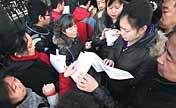
 |
| Illustration by Zhou Tao |
Key Words:city life; megacity;
To escape from hustle and bustle city life:
>>Dreamy log cabins among woods
>>Three must-go hutongs, insight into old Beijing
>>Top resorts exclusively selected for ladies around the world
Gray smog returned to Beijing again over the past few days and forced local residents to wear masks outdoors.
Polluting weather has hit the Chinese capital frequently since the beginning of the year.
A key factor leading to the smog is vehicle exhaust.
About 5.2 million vehicles are running on the roads in the metropolis, which has a population of 20.6 million.
Traffic congestion and shortage of resources, such as water, are also common problems for other large cities in China.
Last Tuesday, delivering a government work report to the first session of the 12th National People's Congress, the Parliament, Premier Wen Jiabao said megacities and large cities should be kept to an appropriate size.
The following day, Zhang Ping, head of the National Development and Reform Commission, said the country should control the expansion of mega and large cities.
China is likely to make a blueprint for the country's urbanization drive in the first half of the year, he added.
By the end of 2012, the country's urbanization level rose to 52.6 percent from 45.9 percent five years ago, marking a historic turning point in the nation's urban-rural population structure. The figure means more than half of the total population live in cities.
In China, a megacity refers to one with a population of 10 million or above and a large city 5 million or more, according to Pan Jiahua, head of the Urban and Environmental Studies Institute at the Chinese Academy of Social Sciences.
Beijing, Shanghai and Chongqing all have a population of more than 20 million. Tianjin, Guangzhou and Shenzhen have a population of more than 10 million.
Authorities believe urbanization offers the largest potential for China to expand domestic demand, which is vital for sustainable growth of the world's second largest economy. The concentration of education, medical care, work opportunities and other resources are major attractions for people who swarm into big cities.
Dense population
However, the excessive density of population will affect the operating efficiency and quality of life, in addition to putting strain on the supply of energy and other resources, said Pan.



















![]()
